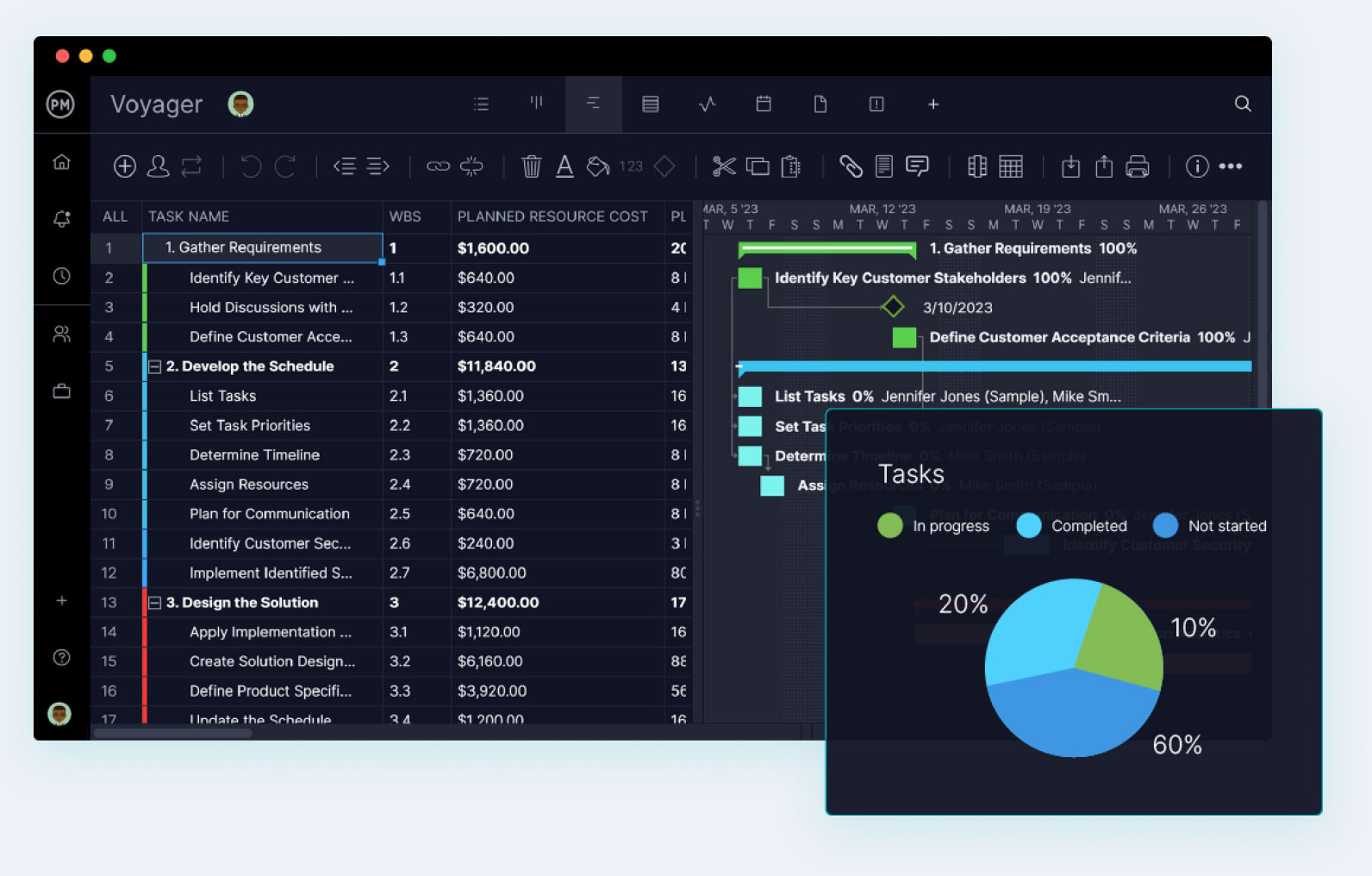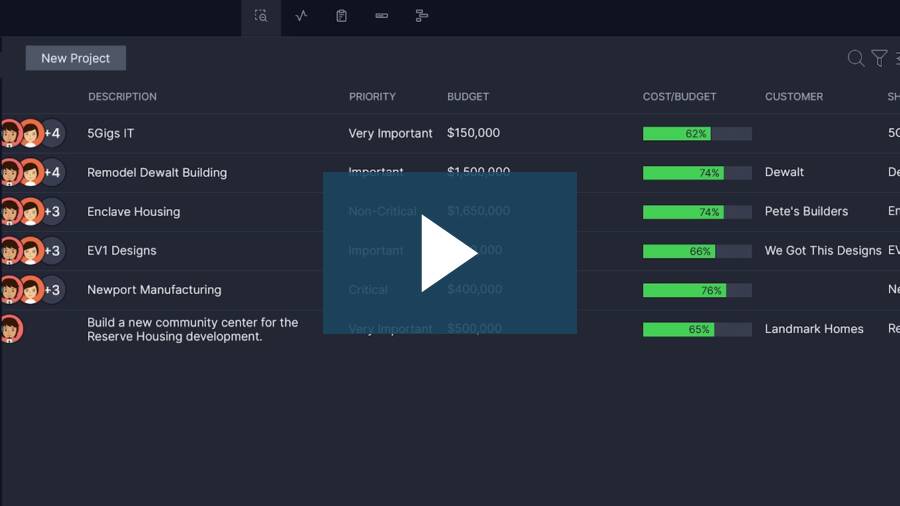- What Is a PMO?
- Project Management Office Functions
- Types of PMO
- Who Can Be Part of a Project Management Office (PMO)?
- What Is the Average Size of a PMO?
- Benefits of Establishing a Project Management Office
- What Is PMO Software?
- How to Set Up a Project or Program Management Office
- What Types of Organizations Use a PMO?
- PMO Resources
What Is a PMO?
A project management office (PMO) is a group or department that defines, maintains and ensures project management standards across an organization. A PMO can either be internal or external. They can also be referred to as a program or project portfolio management office, but they’re different types of PMO. Let’s quickly explain the differences:
- Project Management Office: Provides administrative support for the project management team and standardizes the project-related management processes.
- Program Management Office: Manages the program governance process and coordinates the efforts of the program management team.
- Portfolio Management Office: The project portfolio management office oversees all the projects and programs of an organization and supports project and program management offices.
Related: 15 Free PMO Templates for Excel and Word
A project management office keeps documentation on projects and offers direction and key metrics in the execution of the projects under its governance. Through guidance, the PMO helps organizations get a return on their investment and add value to their stakeholders through projects, programs and portfolios. This is executed with the help of PMO software, which provide data and insights into projects and programs across an organization.
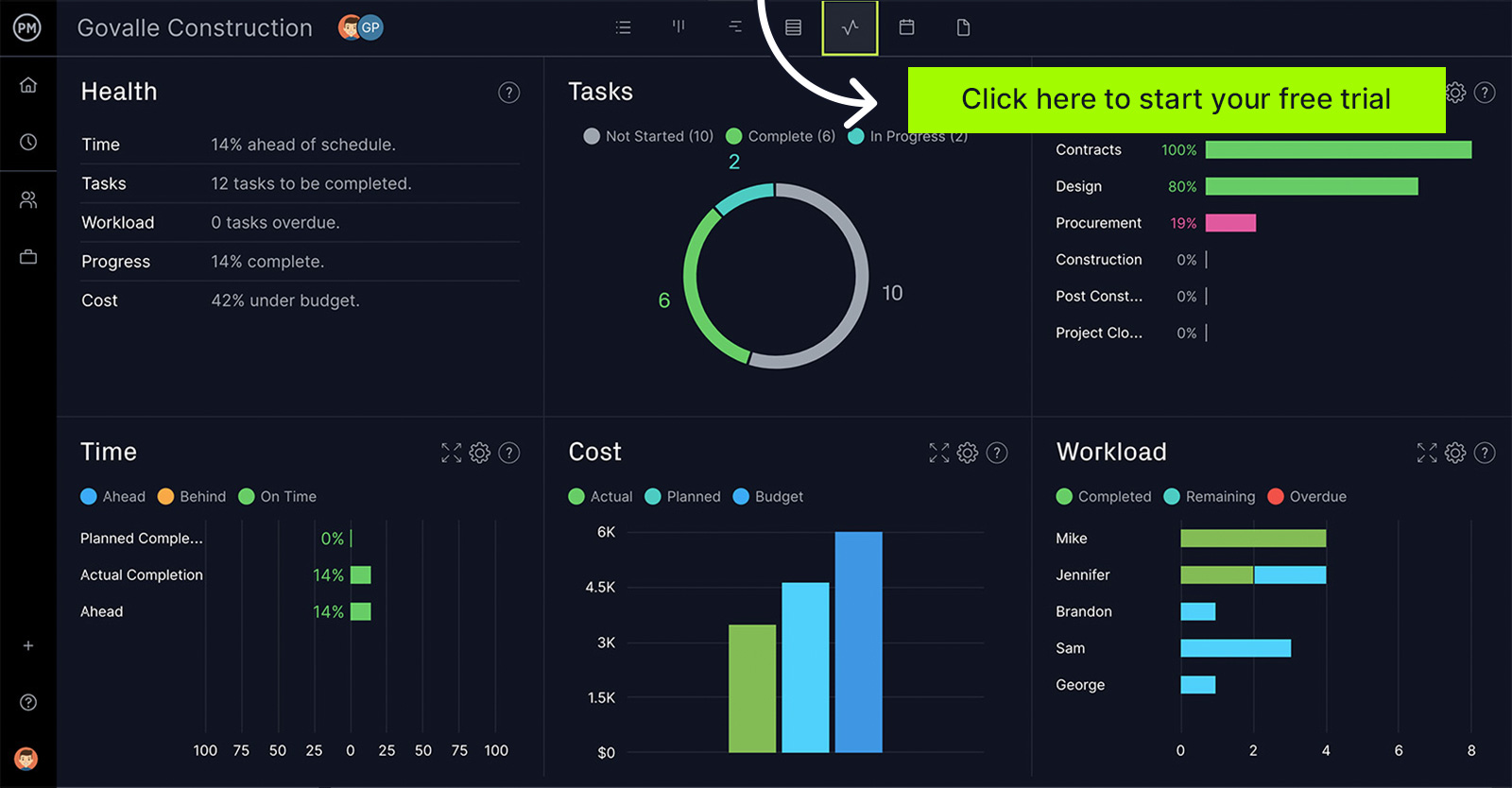
ProjectManager’s online PPM tools help PMOs track portfolios, projects and tasks in one place—learn more.
The PMO doesn’t always focus solely on standards and project management methodologies. They can also be part of strategic project management by facilitating, or even owning, the project portfolio management process. In this capacity, they can monitor and report on active projects and portfolios to top-tier management and foster strategic decision-making.
A project management office is meant to operate as a centralized and coordinated management hub for all the projects, with the aim to create efficiencies between projects—as well as merely defining standards in the project management process.
Project Management Office Functions
One can think of a project management office as a regulatory commission that seeks to standardize the execution of projects in order to maintain productivity. A PMO offers guidance to project managers and develops metrics on the practice of project management.
In general most PMOs act as the backbone of a successful project management approach in any organization. They offer support and information and ensure project and program success. They can be an in-house team of project management professionals, or an external firm that offers PMO as a service. In either one of those cases, the PMO will perform these basic functions.
Most project management offices share these common roles and responsibilities:
- Strategic Planning and Project Governance: This involves defining project criteria, selecting projects that align to business goals and advising management with cost-benefit ratio.
- Defining the Project Management Methodology: Defining the project management methodology that will be used on a project, such as waterfall or an agile framework.
- Best Practices: This includes managing organizational process assets, standardizing procedures and establishing project management practices for all departments in the organization.
- Common Corporate Culture: The project management office should assess the project management maturity of an organization and set common project culture through communication and training on techniques, methodologies and best practices.
- Resource Management: PMOs manage and allocate resources across projects based on priorities, schedules, budgets and more.
- Creates Project Archives, Tools and More: The PMO provides administrative support and invests in templates, tools, software and more to better manage projects.
- Governance: They make sure that the right decisions are being made by the right people based on the right information. This can also include auditing and peer reviews, developing project structure and making sure there’s accountability.
- Transparency: They provide information that is relevant and accurate to support effective decision-making.
- Reusability: There’s no reason to “reinvent the wheel,” so they are a depository of learned lessons, offering templates and best practices from previous successful projects.
- Delivery Support: They facilitate project teams and help them do their jobs more effectively by streamlining process and bureaucracy, offering training, mentoring and quality assurance.
- Traceability: They manage documentation, project history and organizational knowledge.
Types of PMO
No two PMOs operate in exactly the same way, but they can be generally divided into three PMO types:
Supportive PMO
A supportive PMO collects all projects in an organization, and supplies best practices, templates and training, but with a low degree of control. Supportive PMOs act as a consultative role within the company as they have the tools and knowledge to help project teams succeed.
Organizations that want to increase their project success rates without imposing strict controls typically adopt a supportive PMO. Using one in an environment where project teams have various levels of experience and need resources to help standardize processes is ideal. A supportive PMO doesn’t typically enforce compliance but aims to boost project efficiency by making resources available.
Controlling PMO
A controlling PMO checks if the project management tools, processes and standards are being applied in the projects, with some degree of control. This is more of a structured role that enforces compliance with different project management standards, methodologies and governance.
Organizations that need more consistency and oversight when executing projects will typically use a controlling PMO as this role can help ensure that all projects fall under the company’s policies. The controlling PMO will help ensure that frameworks are followed and that teams use the established processes and tools. This workflow offers a balance between guidance and authority that helps reduce project risk by enforcing standardized practices.
Directive PMO
A directive PMO maintains a high degree of control in the project management process within the organization. The directive PMO is actively involved in directly managing and executing projects, working closely with project managers to oversee initiatives.
Organizations that have a high demand for strategic project alignment or those in industries with strict regulatory requirements will typically use a directive PMO. They manage projects and team processes to help ensure a high level of consistency in project outcomes. Keep in mind that this approach is a significant investment in resources and personnel.
Internal PMO
An internal PMO is integrated into the organization to better manage and support projects that align with the company’s strategic initiatives. This role is dedicated to internal projects and project planning to help coordinate and provide governance.
The goal is to drive business value by working within specific departments or the organization as a whole. An internal PMO could take on a supportive, controlling or directive role depending on how much oversight is needed. They are ideal for organizations that want to improve internal inefficiencies and align projects with organizational goals.
External PMO
An external PMO is a PMO that doesn’t belong to the organization that’s executing a project, but rather a third-party PMO consulting firm contracted as a PMO as a service.
The external PMO works to ensure projects meet all client requirements, follow the terms of the contract and achieve the ideal outcomes. This type of PMO focuses on client satisfaction, communication and compliance with service-level agreements. Common responsibilities include risk management, reporting project progress and managing client change requests.
Enterprise PMO
An enterprise PMO’s main goal is to ensure that the projects align with the organization’s strategic objectives. They help to prioritize projects based on how they could impact business goals and create best practices that all projects and teams can adopt.
In addition to providing training programs and resources to improve project management skills within the organization, an enterprise PMO will also help develop and implement standardized project management tools and methodologies. An enterprise PMO will work to define key performance indicators (KPIs) and metrics to determine if a project was successful.
Who Can Be Part of a Project Management Office (PMO)?
A project management office (PMO) is made up of several roles within the organization, such as:
Project Managers
In a PMO, the project manager helps to develop detailed plans that outline the scope, deliverables, objectives, timelines and resource requirements. They will lead project execution, monitor project progress, track milestones and identify risks. Project managers will also act as the main point of contact for project stakeholders as they work to provide updates and gather feedback.
Program Managers
Program managers in a PMO help oversee a collection of related projects to help achieve strategic objectives. They ensure that the program’s goals align with the strategic objectives of the organization and collaborate with stakeholders to determine the program’s outcome and vision. Program managers also work to define the program’s scope, objectives and benefits.
Portfolio Managers
Portfolio managers help ensure that the organization’s projects and programs align with its strategic objectives. They oversee a collection of projects and programs, prioritizing them to ensure alignment with the company’s strategic objectives.
In addition to strategic alignment, portfolio managers help oversee how resources are used across the portfolio to optimize them and reduce conflicts. They regularly review and monitor project KPIs to see how the portfolio is performing and identify risks at the portfolio level.
PMO Manager
A good PMO manager or PMO director oversees the team members in the project management office and takes responsibility for the quality and value of each project under its care.
This involves participating in the project intake process, collaborating with project managers and reporting to the executive staff of the organization.
PMO managers succeed by facilitating project planning, analyzing financial information, modifying processes and ensuring proper documentation for the projects they’re overseeing. This is done by both focusing on details and keeping an eye on the big picture.
Naturally, a PMO manager has to function under pressure, have strong interpersonal skills and be able to prioritize and juggle different projects.
Business Analysts
A business analyst (BA) helps bridge the gap between the needs of a business and project execution. They help ensure the project aligns with the organizational goals by evaluating requirements, facilitating communication and supporting how decisions are made.
The role of a BA includes requirements gathering or collaborating with stakeholders to prioritize business requirements for projects. They also help create detailed documentation including business requirements documents, use cases and functional specifications.
Financial Analysts
In a PMO, a financial analyst plays an essential role in ensuring that projects are financially viable and properly align with the organization’s budgetary goals. This role offers insights into the project costs, funding and financial performance to help stakeholders make informed decisions.
In addition to budget development and cost estimation, a financial analyst in a PMO helps with financial reporting, variance analysis, funding analysis, risk assessment and cash flow management.
Risk and Compliance Officers
Risk and compliance officers play a pivotal role in ensuring that projects are executed to align with the organization’s policies, requirements and risk management practices. They collaborate with project teams to help analyze potential risks throughout the project lifecycle and use tools and techniques to identify risks linked to the project scope, schedule, cost and quality. Once a risk is identified, they help mitigate and monitor them to ensure they don’t become a threat in the future.
What Is the Average Size of a PMO?
PMOs come in various sizes depending on what the company needs, the scope of the projects being managed and the purpose of the PMO.
- Small PMO: A small PMO is considered to be 1-5 people and is typical in small to mid-sized businesses where the PMO is supportive instead of directive. They focus on guidance and basic project tracking.
- Medium PMO: A medium PMO is considered to be 5-15 people and is often found in mid-sized to large businesses with moderate project portfolios. They support the active oversight of projects, enforce standards and directly assist project teams.
- Large PMO: A large PMO is 15 or more people and they are commonly found in large, project-intensive organizations. It includes portfolio managers, program managers and change managers. They support multiple project portfolios and initiatives.
Benefits of Establishing a Project Management Office
Now that you know more about what a PMO is and what it does, we can examine why an organization should have a project management office and how a PMO benefits the organization as a whole.
The PMO Offers Guidance
First, when you have a PMO you have an agency to align the project, program or portfolio with an eye focused on the future strategy of the organization. This allows you to work within the boundaries of a long-term plan and therefore be more efficient in your decision-making thanks to project management office guidance.
Helps Keep Projects on Track
They also act like an external mechanism to ensure project success. Due to their metrics-based assessment, they can help keep projects on track and alert you when scheduling, budget and other scope issues are threatening to derail the project. That way you can act quickly when issues arise—before they become potentially project-ending problems.
PMO has a Big Picture View
When you’re working on a portfolio of projects, the project group has a keen understanding of the links between those projects. They are aware of the dependencies that can impact one another. This provides you with a bird’s-eye view of the work that is often not part of your purview, putting your actions in play on a larger canvas, so you can see how a small move could have larger repercussions.
Helps with Communications
They can also be seen as another arm of your communications plan. They have the ears of your stakeholders in ways that you might not, and therefore can facilitate communications with them, both freeing you up for other work and making sure your message is delivered and understood.
Project management governance can help with communications across the board, too, as they often have working relations with other parts of the project or program participants that you might not be connected with.
PMO Shares Resources Throughout the Organization
Setting up a project management office allows for the sharing of resources. If your resources are limited but your projects aren’t, a program management office can strategize the use of those resources across your project or program to best use them productively.
When you have your projects aligned to a business case and strategy, there are many benefits from support to portfolio management, centralizing training and project management tools, as well as mentoring. Of course, a project management office alone is not enough. You need good people, proven processes and supporting technology to get the most out of it.
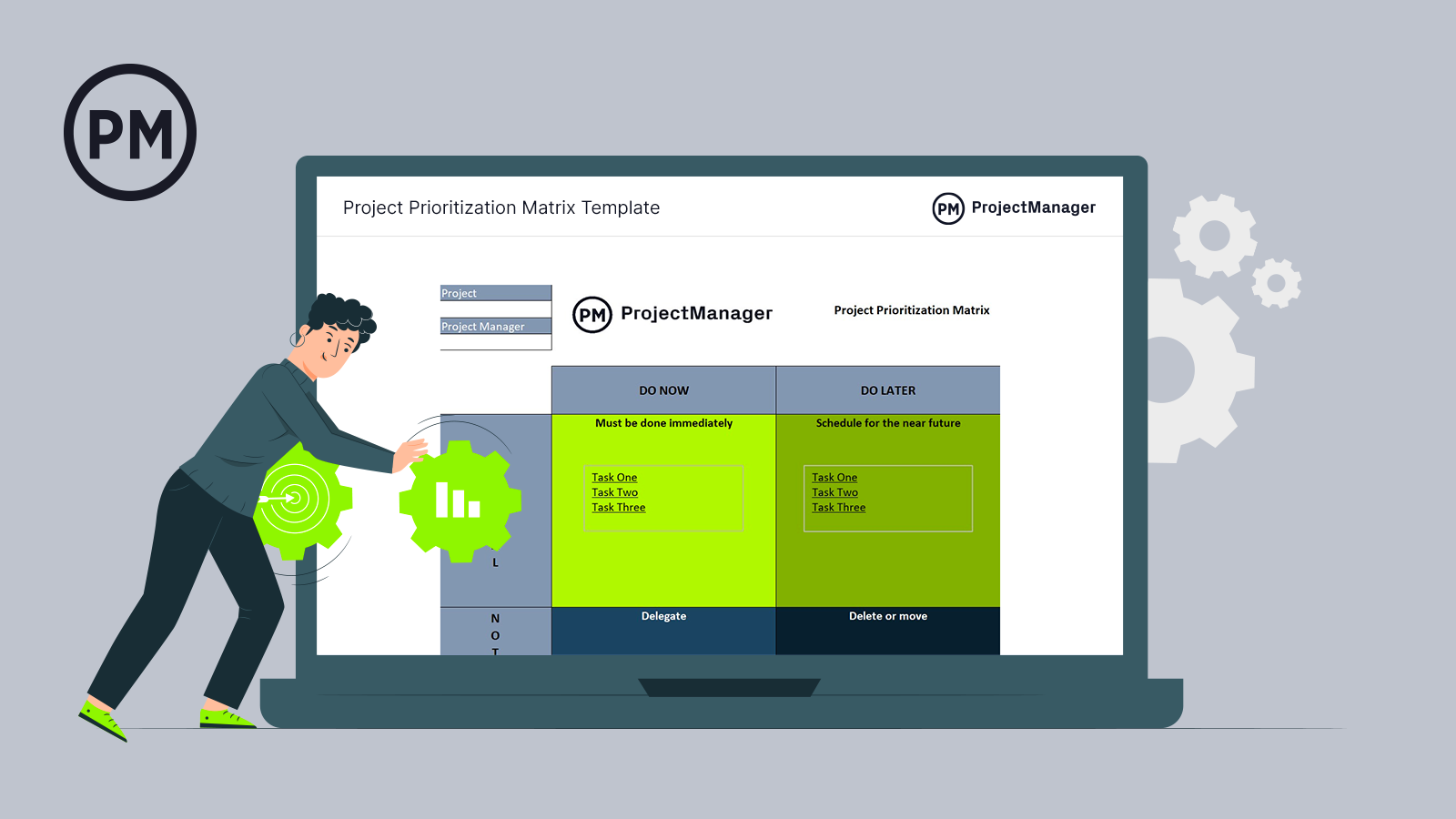
Get your free
Project Prioritization Matrix Template
Use this free Project Prioritization Matrix Template for Excel to manage your projects better.
What Is PMO Software?
PMO software is used to create efficiencies when organizing the process of a project, program or portfolio under the governance of a project management office. This includes every phase of the project: initiation, planning, execution, monitoring and closure.
Some of its functions include analytics, tracking, planning, resource allocation, prioritization, scheduling and reporting for business insights. Project management software also aligns to its organization’s and industry’s standards.
PMO software should be flexible, with the ability to adapt to changes, enterprise environmental factors, and stakeholder expectations. It should be able to manage and analyze teams, while providing collaborative features. A project management software for a PMO should have:
- Project management tools for different project management methodologies.
- Project management tools to manage and analyze teams, while providing collaborative features.
- Resource management features
- Program and project portfolio management features
Since project management software is used to manage more than one project, having program and portfolio dashboards to get a high-level view of performance is usually part of the features set. Microsoft Project is one of the most commonly used project management software, but it has major drawbacks that make ProjectManager a better alternative for project management, program management and portfolio management offices.
Desktop vs Online PMO Software
Desktop PMO software applications tend to be more expensive and require installation; and training can take additional time for everyone to learn it. Online project management tools offer more entry points in terms of price because they have multiple-tier subscriptions. They also tend to be more user friendly and intuitive to use. But which is right for you?
Both have advantages and disadvantages.
The desktop tool is almost always going to operate more quickly, since it’s not at the mercy of an internet connection to determine how fast you get your data. There’s also no delays if the internet goes out. The desktop is a closed system, which can be networked to other computers in the office, but because it’s not online, your work tends to be more secure.
However, online PMO software has made great strides to delivering security with better authorization and customized in-app permissions. Speed still lags, but depending on your connection to the internet the difference can be negligible. But these are still considerations when shopping around for a software that fits your PMO needs.
What an online project or program management office tool can do that a desktop can’t is foster collaboration across your project teams, monitor and track performance and progress in real time. Teams are connected to the tool wherever they are and whatever time they’re working. There’s no need to input data; it’s collected automatically as it occurs. This means PMOs can make better decisions with more accurate data.
Essential PMO Tools
There’s a lot of ground to cover when discussing PMO tools: the demands on PMO software are broad and complex. PMOs need basic project management features such as resource management, task management, workflow management and planning tools, along with more advanced project portfolio features.
In addition, teams need to be able to collaborate and take control over their ongoing projects, as they all impact one another. This ensures that you’re keeping project processes standardized and meeting business goals and objectives.
Here are some essential PMO tools that no project management office should be without—all of which are included in ProjectManager.
Real-Time Project Management Software
The first step in any successful PMO software is that it works in real-time so you can see what’s happening as it happens, and teams get to collaborate.
Our project management software is cloud-based and is instantly updated. Teams know what to work on, and you get transparency into processes to keep projects running smoothly.
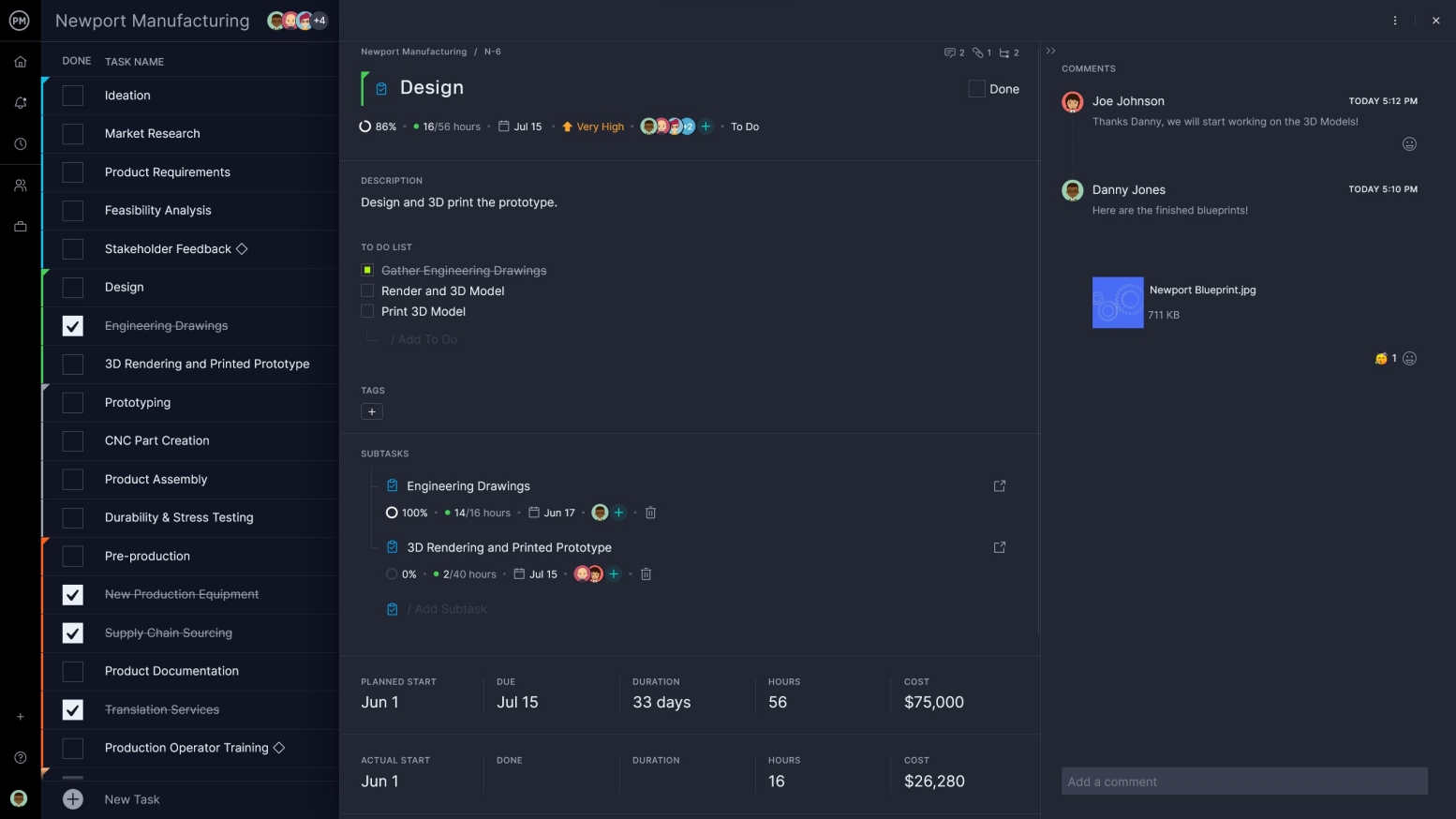
Project Portfolio Management View
PMOs have lots of projects to manage. These projects are not isolated, and most complement each other. Therefore, it’s crucial that PMO software has a portfolio view to see all projects on one screen to be able to quickly note how they relate to one another.
We have multiple project views, including an overview feature where you get a high-level one of all your projects. You have the controls to group and organize them as you want, to drag and drop them into folders or create new folders for each client who needs more specialized attention.
Our software gives PMOs both broad and narrow views of projects. A real-time project portfolio dashboard tracks progress across six project metrics in colorful and easy to share graphs and charts. Get more detailed data with automated reports on status, tasks and timelines.

Project Portfolio Roadmap
While a high-level view is good to track progress, if you’re dealing with standardizing processes and making sure every task is meeting the requirements across all projects, then you must have more detailed data.
With our portfolio roadmap, you see every project you’re managing in your PMO. All the projects are laid out on a timeline on a Gantt chart view. Now you can see each project at the task level and filter the Gantt to get just the information you need, whether that’s by assignee, project manager or customer. We help you make more accurate PMO forecasts.
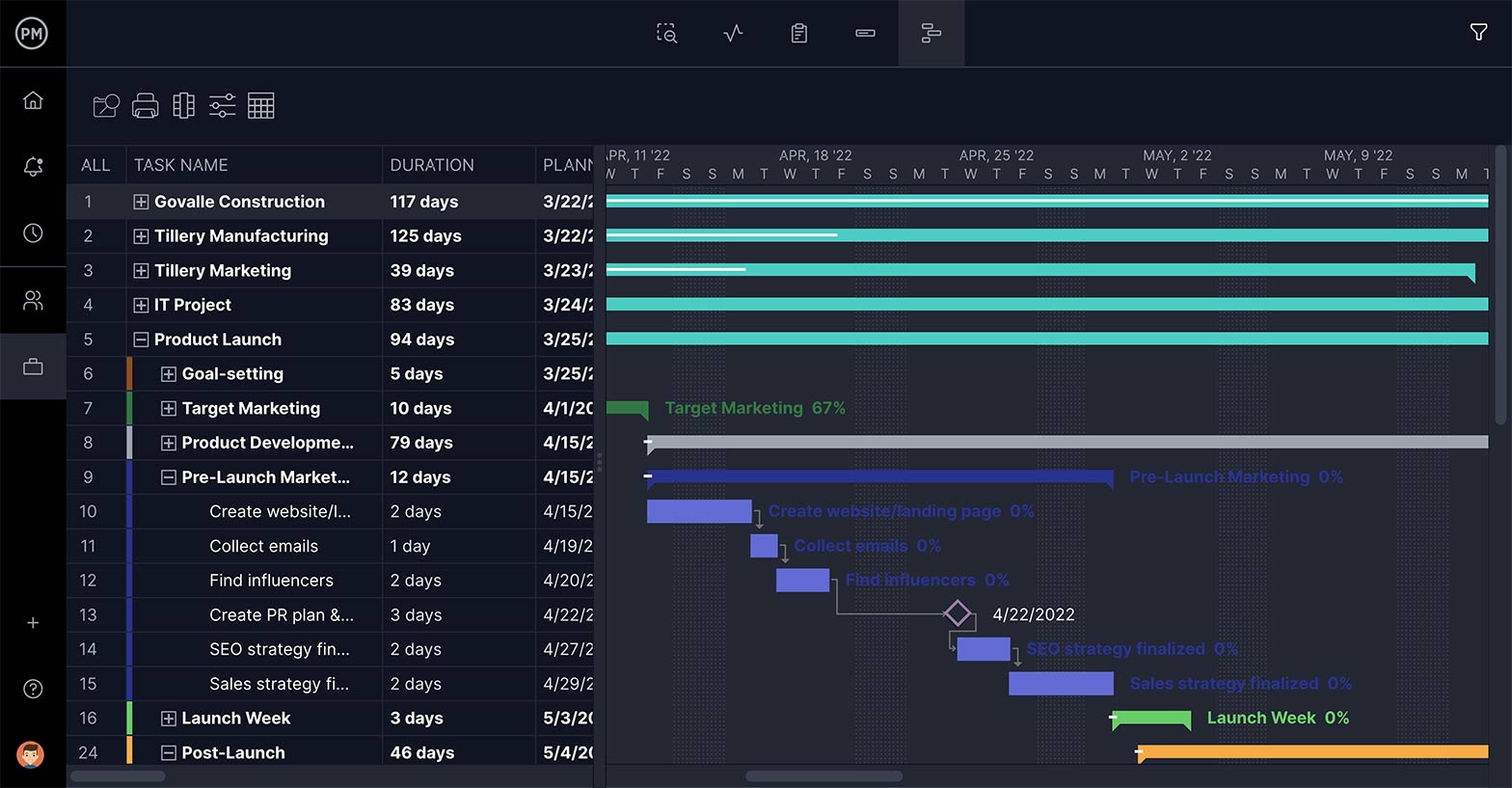
Resource Management
Resources for a project include staff, equipment, materials and more. That’s just for one project. Resource management at the PMO level will help you manage those resources to keep your projects moving forward.
We have a resource management tool that can track, manage and report across your portfolio. You have visibility into your resources and can make sure they’re balanced so that each project has what it needs, when it needs it. Because our software is cloud-based, you can track your project’s performance against the planned work to make sure you’re staying on schedule.
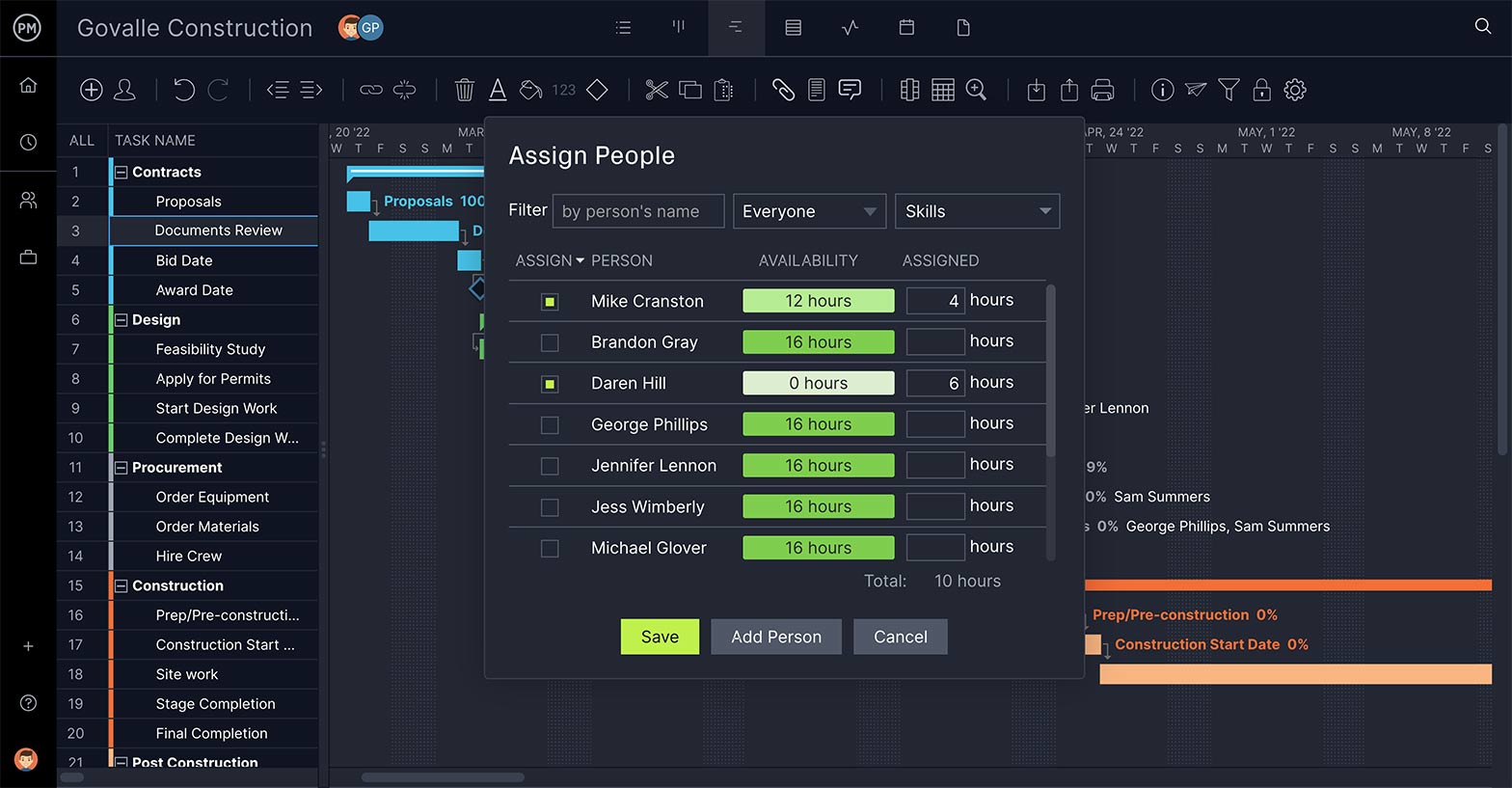
Workload Management
Workload management is a window into a team’s tasks to make sure there are no imbalances. Team workloads vary. If you’re not keeping a close eye on who is tasked with what, teams can find themselves overworked or underworked. Neither is good for productivity or morale.
Our software gives you transparency into the workload of all your projects in easy-to-use color-coded pages. See at a glance who is overallocated and then reallocate resources right from the workload page to balance the team’s workload. It’s that simple: optimize resources in real-time. Now you can make data-driven decisions to better manage your teams in multiple projects.
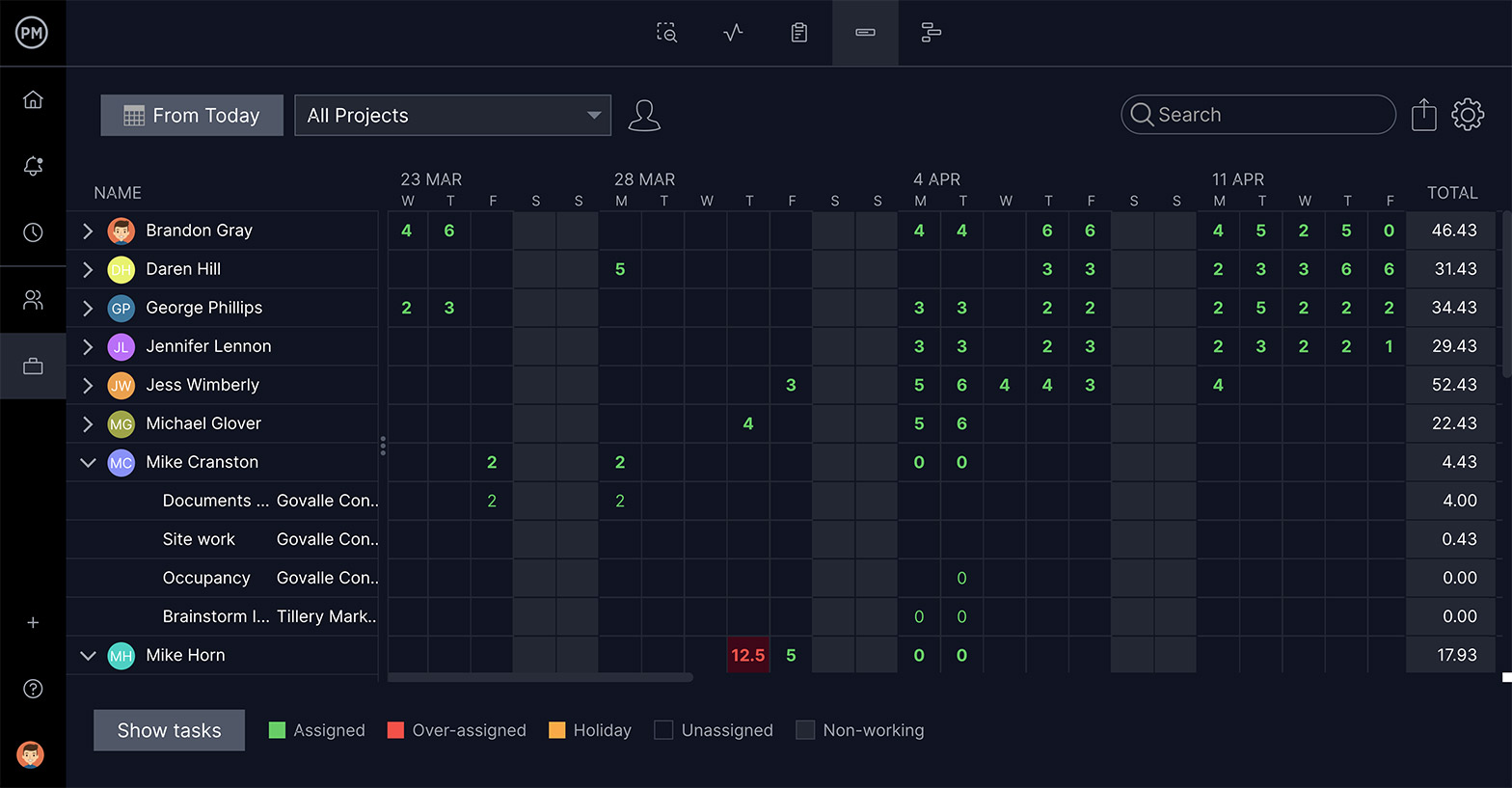
Team Management
There are many ways the PMO looks after their organization, from roadmaps that gather all the tasks of multiple projects on a shared timeline to looking at your projects through the lens of resources. But your most important resource is your teams, and PMOs need a team management tool that provides transparency into their work.
Our Team section makes it even easier to balance resources and assignments. Your projects’ resources appear on the team page, with task progress indicated as colors. There’s a priority level for tasks, too. You can filter the page by team members so that you have even more control over your team’s resources and workload.
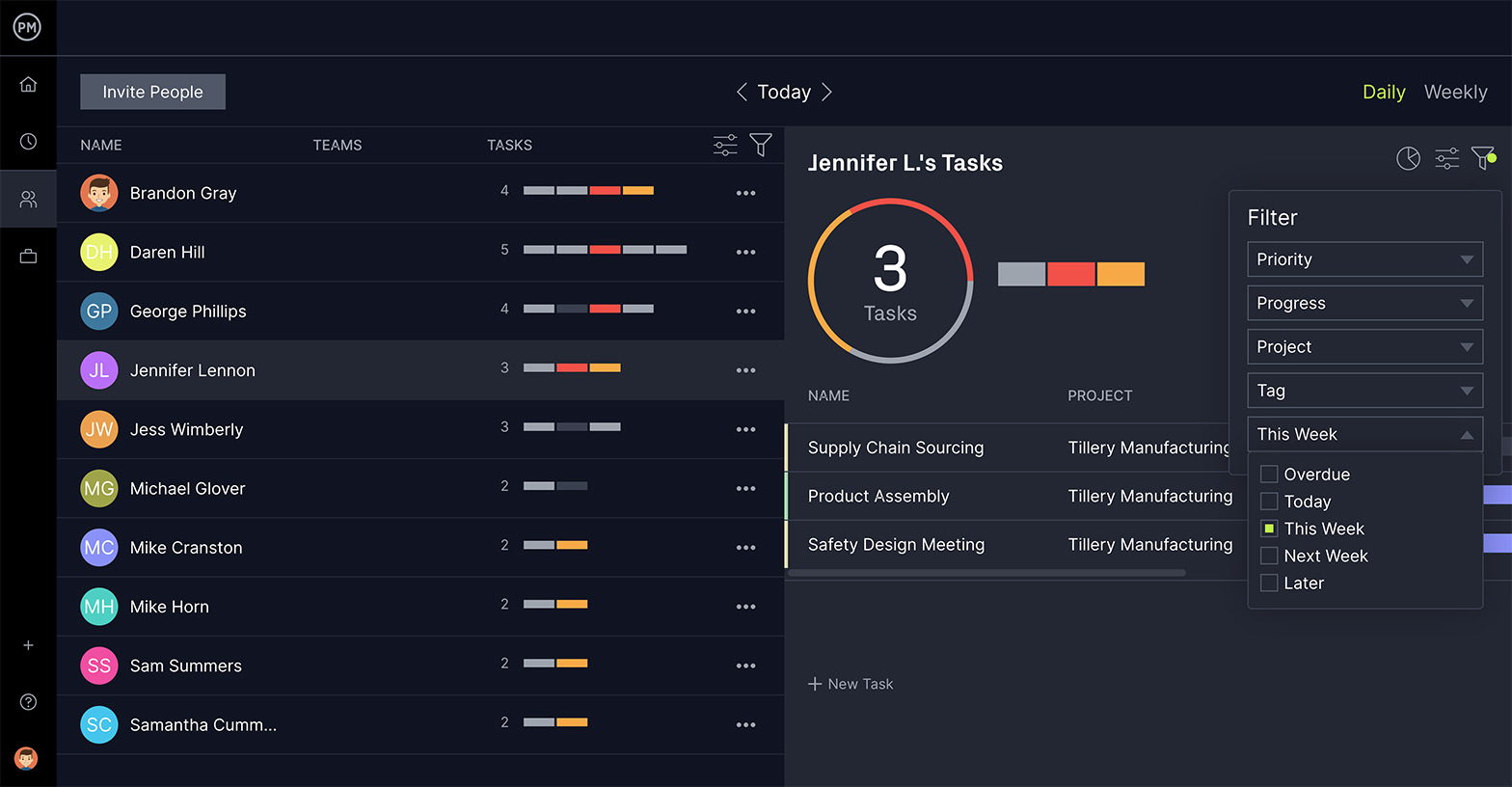
PMO Reports
Reporting is one of the key tools for tracking progress. You can look at the projects from a high-level dashboard view or drill down for more detailed data with reports. Reporting keeps projects on track and stakeholders updated on progress.
Reports can be customized by customer, priority and much more to show what you want to see for better PMO oversight. You can even get reports on specific projects in your PMO, all downloadable and shareable.

To get all of these PMO tools and more, sign up for a free 30-day trial of ProjectManager.
How to Set Up a Project or Program Management Office
You’re probably wondering how you can set up a PMO in your organization. Think of it as another project. So, therefore, you’re going to follow a similar process:
- Analyze the situation
- Form a plan to respond to that situation
- Implement that plan
You’ll need to find someone to back it, ideally someone in management with knowledge of change management. That person must totally understand the venture, be fully onboard with believing in its benefits and then actively promote the process of setting it up.
Step 1: Analyze the Situation
First, analyze the current situation by checking the project management methodologies, processes, and tools that are being used for any signs of weakness. Also, do the same analysis with any ongoing projects. You’ll want to create a complete and up-to-date informative project list, prioritized if possible, to determine who is working on what.
With this information you can document the project management majority of the organization, which is crucial paperwork to refer to later on as you apply improvements to the system. But remember, be delicate in your report and do not neglect the positive, as the process can get very political. No one is served by ruffling feathers.
Determine the goals of the project management system by getting a stakeholder analysis. First, you have to identify the stakeholders and find out what benefits they’re looking for. Stakeholders can include management, executives, project managers, controllers, even staff members. They’re all going to want to see what the value is, so you have to make that clear from the get-go.
Step 2: Design the Plan
Begin by defining its areas of responsibility, hierarchical position and competencies. What’s its mandate and services? For example, is the PMO a service unit providing tools as required or is it set up for training and support of project managers to ensure project quality?
There are many areas that a PMO can find itself responsible for, some of which are sketched out in the list below:
- Training and coaching, attending to staff development for project members and teams
- Defining project management methodologies and best practices
- Operation support, holding workshops or temporarily taking on work as project controller
- Methods and processes, which might include project management tools
- Project setup and implementation, selecting projects and prioritizing them through cost-benefit analysis and other conditions
Don’t overload your project management office from the start. That’s a recipe for disaster. To ensure you’re productive, stick to just one or two areas of responsibility. Your stakeholders might want to overload it with too many responsibilities and tasks, so speak with them about realistic goals and practical paths forward.
Remember that the PMO is a new entity in the organization, so it’s going to take time before it’s commonplace. There will be a learning curve. Make sure all employees are introduced to the PMO and briefed on what it’s responsible for. This provides clarity and promotes its services so people use them.
Step 3: Implement the Plan
Just as you would in any other project plan, proceed step-by-step, provide the IT infrastructure and finalize the PMO staff training. Focus on change management, as this is one of the foundational tasks. And you want to cement organizational buy-in, so it doesn’t hurt to reiterate the beneficial reasons for implementing it.
When you’re communicating the PMO’s areas of responsibility, you can do so on the company’s intranet or whatever platform or venue is best. However you disseminate this information, be sure to include these three things:
- What are its services
- The processes in the company’s project management
- Who is the team leader
Once you’re in operation and internal staff has assumed full responsibility, if it has been set up by an external consultancy, the new project office has to persuade all stakeholders of the benefits it brings. This usually results in the following phases:
- Scenario 1: Early success, happy stakeholders.
- Scenario 2: Period of disenchantment, which is not unusual after implementing a new structure or competency, but it can lead to some skepticism.
- Scenario 3: Initial skepticism evolves into constructive collaboration as the project office establishes itself in the culture.
What Types of Organizations Use a PMO?
PMOs are used across various types of organizations, we’ve listed some examples below.
Large Corporations
Large corporations implement PMOs to help standardize project management processes across departments. PMOs have operations that span various business units and locations so they help ensure that projects are consistent and aligned with corporate strategy. By centralizing timelines, resources and methodologies, a PMO in a large organization can help improve project and business outcomes.
Government Agencies
A government agency will use a PMO to help guarantee compliance, transparency and efficiency in projects that impact public services and resources. They face regulatory and budgetary constraints, so a PMO can help enforce standardized processes, track resource allocation and guarantee accountability. In government settings, PMOs often oversee programs related to healthcare, education and infrastructure.
Construction Firms
Construction firms utilize PMOs to help take care of intricate requirements for large-scale and multi-purpose projects. They oversee all stages, from design to completion, to ensure the project adheres to strict timelines, quality standards and budgets. In construction firms, a PMO helps coordinate subcontractors, permitting, procurement and resource allocation across various project sites. It helps standardize processes to reduce errors and improve communication among architects, engineers and project managers.
Professional Services and Consulting Companies
A professional services or consulting company can use a PMO to help ensure quality, consistency and client satisfaction across various projects and initiatives. These PMOs help manage timelines, maintain communication with clients and coordinate resources. PMOs help to standardize methodologies and reporting to help deliver higher-quality projects that surpass stakeholders’ expectations.
IT and Software Companies
IT and software companies utilize a PMO to streamline the project management process across fast-paced and dynamic software development environments. They usually support agile or hybrid methodologies that allow teams to be flexible while ensuring alignment with the larger company goals. The oversee project portfolios, resources and timelines to help meet delivery schedules. In IT, a PMO focuses on manging risk, ensuring quality and aligning stakeholders.
Final Thoughts on PMOs
As noted earlier, a PMO’s success depends on appointing the right person to promote it. Sometimes they’re going to have to demand unpopular changes, so the only way for them to be successful is with backing from management, and with clearly defined responsibilities and competencies.
Then there’s the culture in the organization, and it will likely take time for the project management office to settle into this establishment smoothly. For this transition to occur successfully there must be transparency in the project environment. Therefore, how transparency is applied in the company culture is going to either help or be a hurdle.
But once the PMO has been established and it begins to benefit your projects, you’ll find it an integral part of the organization as a whole. It helps support success and provides an overview for project managers who might not always see the whole picture, allowing them to do better work for their company and for their teams.
Ready to start a PMO at your business? Make sure you give them the best tools for the job. Sign up for a free trial of ProjectManager, so your PMO can have a positive impact on your organization.
PMO Resources
Articles
- Project Management Trends (2022)
- How to Manage Multiple Projects: Strategies & Tools
- Project Prioritization for PPM
- Project Manager Titles – A Quick Guide
- How to Hire a Program Director
- Enterprise Project Management: Benefits, Challenges & Tools
- Project Organization 101: How to Structure Your Project
Videos
Software
Templates
Start your free 30-day trial
Deliver faster, collaborate better, innovate more effectively — without the high prices and months-long implementation and extensive training required by other products.
Start free trial